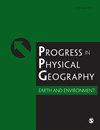Impact of functional groups on aboveground biomass in alpine grassland communities
IF 3.6
3区 地球科学
Q2 GEOGRAPHY, PHYSICAL
Progress in Physical Geography-Earth and Environment
Pub Date : 2024-08-27
DOI:10.1177/03091333241280095
引用次数: 0
Abstract
Alpine grasslands on the Tibetan Plateau (TP) are highly vulnerable to various treatments and face significant degradation risks due to global environmental changes. However, the response of these grasslands to different external treatments remains uncertain, and the patterns behind functional group responses are unclear, impeding our ability to restore alpine grasslands under changing climate. To address this gap, we compiled a comprehensive database of 797 experimental observations of alpine grasslands in the TP, classified these communities into four common functional groups (e.g., grass and sedge), and conducted a meta-analysis to evaluate the response of aboveground biomass (AGB) to nine different treatments (e.g., grazing and nitrogen addition). Meta-regression was used to analyze the changes in AGB with treatment intensity and duration. We also used functional group asynchrony and unevenness to describe the complementary effects (CEs) and selection effects (SEs) of communities under these treatments. We found that among all the nine treatments, grazing had the biggest negative impact on the alpine grassland community by reducing AGB by 40.3%, mainly through decreasing the biomass of grass and sedge. Conversely, nitrogen and phosphorus addition had the largest positive effect, increasing AGB by 39.4% mainly by promoting the growth of grass. However, the increase in AGB was not significant in the interactive experiments involving grazing and nitrogen addition. The unevenness of the community decreased as grazing time prolongs, simplifying the structure of the community, with severe nutrient losses and weakened CE, while nitrogen addition could rapidly increase the AGB of grass and enhance the SE. CE or SE of communities can be enhanced through the restoration of specific functional groups, favoring the recovery of vegetation. Our study also revealed the potential of nitrogen compensation for repairing the damage caused by overgrazing on alpine grasslands.功能群对高山草地群落地上生物量的影响
青藏高原(TP)的高寒草地极易受到各种处理方法的影响,并面临全球环境变化导致的严重退化风险。然而,这些草地对不同外部处理的反应仍不确定,功能群反应背后的模式也不清楚,这阻碍了我们在气候变化下恢复高寒草地的能力。为了填补这一空白,我们汇编了一个包含 797 个对热带雨林高寒草地的实验观测数据的综合数据库,将这些群落分为四个常见的功能群(如草和莎草),并进行了元分析,以评估地上生物量(AGB)对九种不同处理(如放牧和氮添加)的响应。元回归用于分析 AGB 随处理强度和持续时间的变化。我们还利用功能群异步性和不均匀性来描述这些处理下群落的互补效应(CE)和选择效应(SE)。我们发现,在所有九种处理中,放牧对高寒草地群落的负面影响最大,主要通过减少草和莎草的生物量,使AGB减少了40.3%。相反,氮和磷的添加产生了最大的积极影响,主要通过促进草的生长使 AGB 增加了 39.4%。然而,在放牧和氮添加的交互实验中,AGB 的增加并不显著。随着放牧时间的延长,群落的不均匀度降低,群落结构简化,养分损失严重,CE减弱,而氮的添加能迅速增加草的AGB,提高SE。群落的CE或SE可以通过恢复特定的功能群来增强,从而有利于植被的恢复。我们的研究还揭示了氮补偿在修复过度放牧对高寒草地造成的破坏方面的潜力。
本文章由计算机程序翻译,如有差异,请以英文原文为准。
求助全文
约1分钟内获得全文
求助全文
来源期刊
CiteScore
7.20
自引率
5.10%
发文量
53
审稿时长
>12 weeks
期刊介绍:
Progress in Physical Geography is a peer-reviewed, international journal, encompassing an interdisciplinary approach incorporating the latest developments and debates within Physical Geography and interrelated fields across the Earth, Biological and Ecological System Sciences.

 求助内容:
求助内容: 应助结果提醒方式:
应助结果提醒方式:


